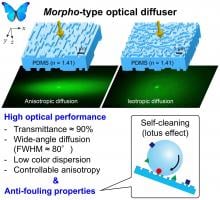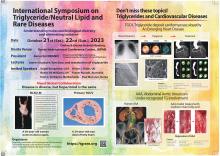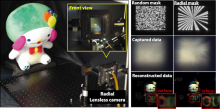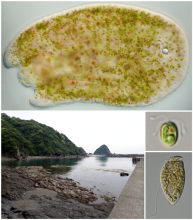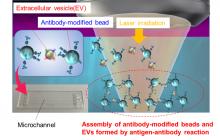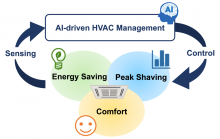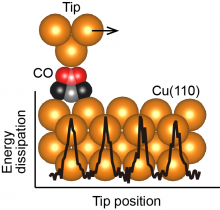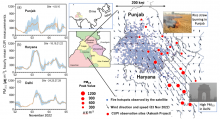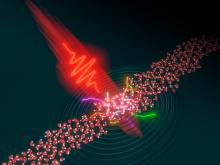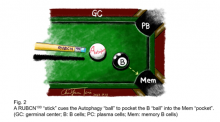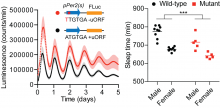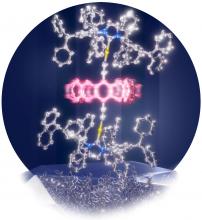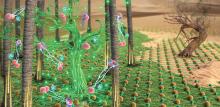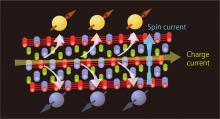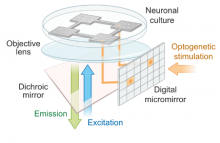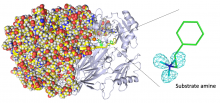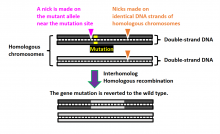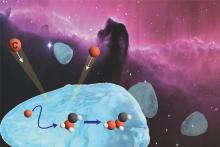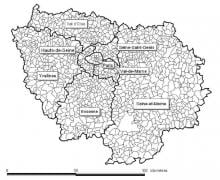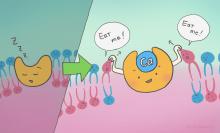Peer Reviewed
News
11 Oct 2023
In a recent publication in EPJ Quantum Technology, Le Bin Ho from Tohoku University’s Frontier Institute for Interdisciplinary Sciences has developed a technique called "Time-dependent Stochastic Parameter Shift" in the realm of quantum computing and quantum machine learning. This breakthrough method revolutionizes the estimation of gradients or derivatives of functions, a crucial step in many computational tasks.
11 Oct 2023
A research team led by Osaka University developed a theranostics approach to both diagnose and treat certain pancreatic cancer cases. They radioactively labeled a monoclonal antibody targeting glypican-1, which is highly expressed in pancreatic cancer, then administered it to disease model mice. One label, 89Zr, showed high uptake in tumors, which would allow early detection of pancreatic cancer with PET scans. Another label, 211At, was used with alpha therapy to significantly slow tumor growth.
11 Oct 2023
Researchers at Osaka University developed a nanostructured light diffuser that provides balanced lighting by diffracting blue and red light, and can be cleaned by simple rinsing with water. The diffuser consists of cheap materials and can be shaped with common tools. A protective glass coating maintains the diffuser’s optical performance yet adds durability. This work might improve the visual performance of everyday lighting displays.
11 Oct 2023
The International Symposium on Triglyceride/Neutral Lipid and Rare Diseases will be held at the Kyoto International Conference Center on October 21 and 22, 2023. The symposium is organized by the International Symposium on Triglyceride/Neutral Lipid and Rare Diseases Conference Committee, which is led by Dr. Ken-ichi Hirano (Graduate School of Medicine, Osaka University) and the Japan Intractable Diseases (Nanbyo) Research Foundation.
10 Oct 2023
To extend the depth of field in mask-based lensless cameras, researchers from Osaka University replaced conventionally coded masks with a radial-coded mask optimized to balance the frequency response. As a result, the point spread function depends less on distance, and subjects at various depths can be clearly imaged. Experiments in simulation and on a prototype show that the depth of field of the camera is extended when the proposed radial mask is used.
05 Oct 2023
Acoels have been found to host a wide diversity of symbiotic, photosynthetic microalgae.
05 Oct 2023
Osaka Metropolitan University researchers have used the power of laser light to accelerate the reaction between cancer cell-derived extracellular vesicles—a kind of nanoparticle—and antibody-modified microparticles. The three-dimensional structure of the resulting aggregates was then analyzed using a confocal optical system. The results demonstrated the ability to measure, within 5 minutes, approximately 1,000 to 10,000 nanoscale EVs contained in a 500 nL sample.
04 Oct 2023
Insect cyborgs may sound like something straight out of the movies, but hybrid insect computer robots, as they are scientifically called, could pioneer a new future for robotics. It involves using electrical stimuli to control an insect’s movement. Now, an international research group has conducted a study on the relationship between electrical stimulation in stick insects' leg muscles and the resulting torque (the twisting force that causes the leg to move).
03 Oct 2023
Researchers from Osaka University have developed a data-driven AI algorithm for controlling the heating and cooling of an office building. The system does not require ambient sensors or specific knowledge of the building’s rooms. During heating operations, the system was able to achieve energy savings of up to 30%, which can represent significant reductions to cost and environmental impact.
03 Oct 2023
Friction, an everyday phenomenon, has perplexed scientists for centuries. Though extensively researched, our understanding remains fragmented, primarily due to the multifaceted interactions that span across varying scales. Achieving an accurate grasp of the precise contact conditions between objects has been a longstanding challenge, a
feat recently made possible through advancements in scanning probe microscopy.
03 Oct 2023
The researchers from Osaka University showed how two psychological factors, belief in just deserts (BJD) and human rights restrictions (HRR), differ across countries. BJD tended to be higher in Japan and lower in the UK, whereas HRR was higher in China and lower in Japan. Public health messages for high-HRR individuals could potentially be used effectively to reduce disease-related discrimination and prejudice.
02 Oct 2023
The annual burning of crop residue in India causes widespread air pollution, particularly in the northwestern regions. A group of international researchers has used low-cost yet reliable instruments to gauge the effects of air pollution in these areas, making it the first quantitative study of its kind.
29 Sep 2023
The behavior of electrons in liquids is crucial to understanding many chemical processes that occur in our world. Using advanced lasers that operate at the attosecond, a team of international researchers has revealed further insights into how electrons behave in liquids.
29 Sep 2023
The authors discovered a shorter isoform of Rubicon called RUBCN100, which enhances autophagy in B cells.
29 Sep 2023
The authors identified a structure in the circadian mRNA Period2 that affects the sleep-wake cycle. The results indicate how translation and post-transcriptional processes influence the body’s internal clock and its impact on sleep patterns.
29 Sep 2023
Researchers at Osaka Metropolitan University have succeeded in printing uniformly sized droplets with a diameter of approximately 100 µm using a liquid film of fluorescent ink. This ink, with a viscosity roughly 100 times that of water, was irradiated with an optical vortex, resulting in prints of exceptional positional accuracy at the micrometer scale.
29 Sep 2023
Concave, umbrella-like metal complexes provide space to enable the largest molecular rotor operational in the solid-state.
21 Sep 2023
A group of researchers have unraveled the mysteries behind a recently identified material—zirconium nitride (ZrN) —that helps power clean energy reactions. Their proposed framework will help future designs for transition metal nitrides, paving a path for generating cleaner energy.
21 Sep 2023
A recent discovery in spintronics could potentially transform future electronics. A group of researchers have revealed the key role of cobalt-tin-sulfur in reducing energy consumption, unlocking new possibilities for high-speed, low-power spintronic devices.
20 Sep 2023
Scientists have revealed that the outer part of our brain (the cortex) is skilled at managing all the info it gets from the outside world thanks to special groups of nerve connections called modules, which work together but also independently.
20 Sep 2023
The physical laws of everyday water flow were established two centuries ago. However, scientists today struggle to simulate disrupted water flow virtually, e.g., when a hand or object alters its flow.
A research team from Tohoku University has harnessed the power of deep reinforcement learning to replicate the flow of water when disturbed. The replication allowed for recreating water flow in real time based on only a small amount of data, opening up the possibility for virtual reality interactions involving water.
20 Sep 2023
A team led by researchers at SANKEN (The Institute of Scientific and Industrial Research), at Osaka University has used neutron crystallography to image all of the atoms in a radical intermediate of a copper amine oxidase enzyme. They disclosed previously unknown details, such as precise conformational changes, that help to explain the enzyme's biochemistry. This work might help researchers engineer enzymes that facilitate unusual chemistry or are highly efficient at room temperature that are useful in chemical industry.
19 Sep 2023
An international group of researchers have discovered a previously unknown species of large foraminifer, shedding new light on the ecological evolution and biodiversity of coral reefs in the Ryukyu Islands.
15 Sep 2023
Researchers led by Osaka University developed a novel genome editing technique known as NICER, which results in significantly fewer off-target mutations than CRISPR/Cas9 editing. The technique uses a different type of enzyme that makes single-stranded “nicks” in the DNA. Repair of these nicks is more efficient and accurate than repair of double-strand breaks caused by the current CRISPR/Cas9 editing. This technique represents a novel approach for the treatment of genetic diseases caused by heterozygous mutations.
15 Sep 2023
A reanalysis of studies on night shift naps reveals the ideal snoozing schedule that may help combat fatigue and drowsiness when staying up all night.
14 Sep 2023
Lab-based studies reveal how carbon atoms diffuse on the surface of interstellar ice grains to form complex organic compounds, crucial to reveal the chemical complexity in the universe.
14 Sep 2023
- Team led by Professor Choi Hong-Soo at DGIST enhances the effects of magnetic hyperthermia and particle penetration into cancer cells through the chain disassembly mechanism of magnetic nanoparticles induced by magnetic fields and magnetic propulsion.
- Expected to play a major role in targeted drug delivery for cancer treatment through research related to magnetic carriers.
- The research findings have been published in ACS Nano, a top-tier journal in the field of materials science.
14 Sep 2023
- Team led by Professor In Soo-Il at DGIST develops a titanium dioxide photocatalyst with enhanced optical and electrical properties utilizing silver and ruthenium
- 135-fold increase in methane production compared to conventional TiO2 photocatalysts (95% selectivity proven)
14 Sep 2023
Researchers have explored the efficacy of combining solar panels on rooftops with electric vehicles acting as storage batteries in Paris and its surrounding areas, finding some encouraging results.
14 Sep 2023
Scientists have found that extracellular calcium mediates the activation of a membrane protein that waves the flag signalling cell death
Events
Sorry, no events coming up for this topic.
Researchers
Sorry, no researchers coming up for this topic.
Giants in history
Sorry, no researchers coming up for this topic.




